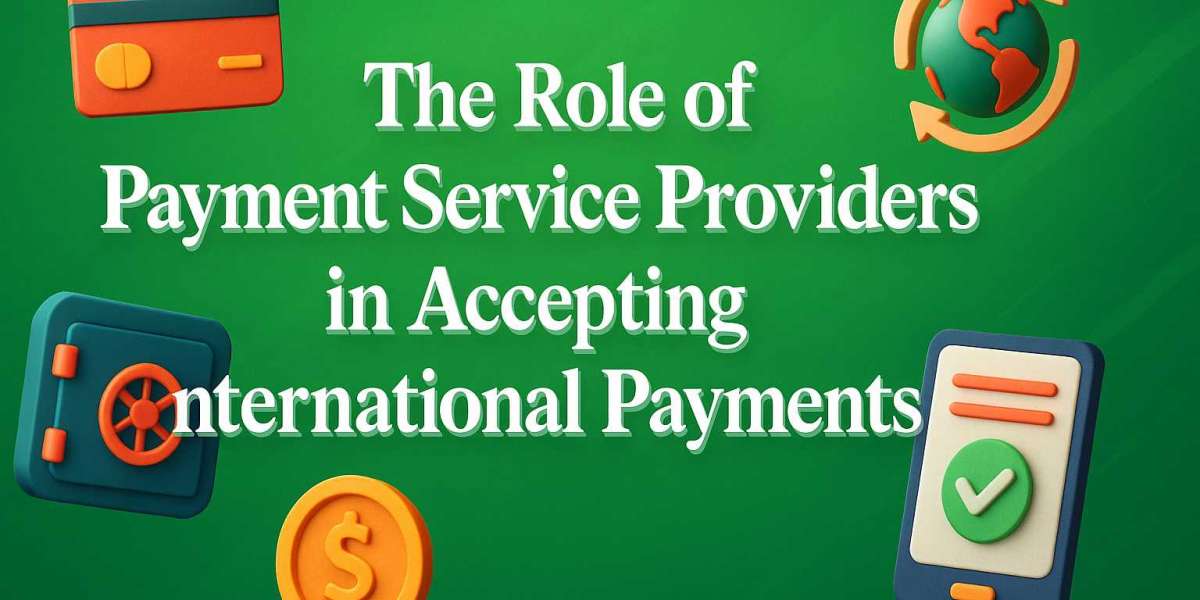In today’s digital-first, borderless economy, businesses of all sizes — from startups to global enterprises — are increasingly expanding their reach beyond domestic markets. Whether it’s a SaaS company onboarding global clients or an e-commerce brand shipping worldwide, the ability to accept international payments efficiently and securely has become a vital success factor.
However, managing international transactions comes with challenges: multiple currencies, regulatory requirements, differing local payment preferences, and fraud risks.
This is where Payment Service Providers (PSPs) play a crucial role. PSPs act as the infrastructure that enables businesses to process, manage, and secure payments across borders, helping them scale globally without the complexity of traditional banking systems.
In this comprehensive guide, we’ll explore how PSPs power international payments, the challenges they solve, and the key features that make them indispensable for global growth.
Why International Payments Matter for Modern Businesses
The rise of global e-commerce and digital services has redefined how businesses grow. According to McKinsey’s 2024 Global Payments Report, cross-border transactions account for over 25% of global online trade, and this number continues to rise.
Why accepting international payments matters:
Access to global customers: Businesses can reach new markets and audiences.
Revenue diversification: Reduces dependency on one market or currency.
Competitive advantage: Offering local payment options builds trust with global customers.
Global brand image: Enhances credibility and reach in international markets.
But accepting payments across borders isn’t as simple as flipping a switch. Different countries have unique financial regulations, currency systems, and payment preferences. Without the right tools, managing all these variables becomes operationally and technically overwhelming.
That’s where Payment Service Providers step in — simplifying international transactions while ensuring compliance and customer satisfaction.
What Are Payment Service Providers (PSPs)?
A Payment Service Provider (PSP) is a company that enables merchants to accept digital payments from customers. PSPs connect businesses to multiple payment methods, banks, and card networks (like Visa, Mastercard, and local systems) through a single platform or API.
Key functions of PSPs include:
Processing online and in-store payments.
Supporting credit/debit cards, e-wallets, UPI, and bank transfers.
Managing foreign exchange (FX) and multi-currency settlements.
Ensuring compliance with regulations (KYC, AML, PCI-DSS).
Providing fraud detection and chargeback management.
In essence, PSPs bridge the gap between businesses and global payment systems, enabling seamless transactions worldwide.
Core Capabilities of Payment Service Providers in International Payments
Let’s explore how Payment Service Providers empower businesses to manage and scale international transactions efficiently.
1. Multi-Currency Local Payment Method Support
One of the biggest hurdles in international transactions is currency diversity. Customers prefer paying in their local currency — and businesses that support this tend to see higher conversion rates.
PSPs make this possible by:
Allowing payments in multiple currencies (USD, EUR, GBP, INR, AUD, etc.).
Automatically converting currencies at competitive FX rates.
Supporting localized payment methods, including:
UPI (India)
iDEAL (Netherlands)
SEPA (Europe)
Alipay WeChat Pay (China)
Klarna, Sofort, PayPal, and others
Example:
An Indian SaaS company using Stripe or Airwallex can bill clients in USD or GBP and receive settlements directly in INR — eliminating manual conversions and currency volatility.
? Result: Better customer experience, fewer abandoned checkouts, and simplified accounting.
2. Global Settlement Reconciliation
When operating internationally, businesses often juggle multiple accounts and intermediaries. Settlements can take days, and tracking payments becomes chaotic.
PSPs simplify global settlement by offering:
Unified dashboards to view all transactions globally.
Automated reconciliation between invoices and payments.
Transparent FX fees and conversion rates.
Faster settlements (sometimes same-day payouts).
Example:
Airwallex and Payoneer provide global collection accounts — allowing businesses to receive, hold, and convert multiple currencies in one place.
? Result: Smoother cash flow and reduced operational costs.
3. Compliance, Regulation Risk Management
Compliance is one of the biggest barriers to international expansion. Each region has unique rules regarding money movement, taxes, and data privacy.
Leading Payment Service Providers handle compliance by:
Maintaining global financial licenses (FCA, RBI, MAS, etc.).
Ensuring AML (Anti-Money Laundering) and KYC (Know Your Customer) standards.
Adhering to PCI-DSS Level 1 for data security.
Supporting GDPR and local data protection laws.
Providing tax management tools to handle VAT/GST obligations.
Example:
Stripe’s tax automation and PayPal’s compliance integrations allow global merchants to automatically calculate and collect regional taxes without manual input.
? Result: Businesses expand internationally with confidence and minimal regulatory headaches.
4. Seamless API Integration Developer Experience
For SaaS founders and developers, integration flexibility is critical. PSPs that offer developer-friendly APIs allow faster setup and easier customization.
Top PSPs offer:
Comprehensive APIs for payments, refunds, and subscriptions.
SDKs for web, mobile, and POS systems.
Webhook-based notifications for real-time transaction updates.
Sandbox testing environments for safe experimentation.
Example:
Checkout.com and Stripe enable developers to launch cross-border payment flows in under an hour — integrating APIs that support 135+ currencies.
? Result: Faster go-to-market and easier scalability for tech-driven teams.
5. Optimized Checkout Conversion for Global Customers
Your checkout experience is the final step between intent and purchase — and PSPs can make or break this moment.
PSPs improve checkout conversion by:
Offering localized checkout pages (language, currency, payment icons).
Supporting one-click payments and stored credentials.
Reducing friction with AI-based payment routing and retries.
Ensuring multi-device responsiveness for global users.
Example:
A SaaS company switching to Adyen’s optimized checkout flow saw a 14% uplift in conversions from international traffic.
? Result: Higher conversions and improved customer satisfaction across regions.
6. Fraud Prevention Security in Global Transactions
Cross-border transactions often face higher fraud risks.
To protect both merchants and customers, PSPs invest heavily in AI-driven fraud detection and tokenization.
Security features include:
Real-time fraud detection systems using machine learning.
3D Secure 2.0 authentication for added buyer verification.
End-to-end encryption and tokenization.
Chargeback monitoring and prevention tools.
Example:
Adyen’s “RevenueProtect” and Stripe Radar leverage billions of transaction data points to block fraudulent payments while maintaining a smooth user experience.
? Result: Safer transactions, fewer chargebacks, and increased trust among international customers.
Challenges in Accepting International Payments (and How PSPs Solve Them)
| Common Challenge | How PSPs Solve It |
|---|---|
| Multiple intermediaries delayed settlements | Unified platform with direct bank integrations and fast payouts |
| Hidden FX fees conversion costs | Transparent pricing and local currency accounts |
| Compliance regulatory complexity | Built-in global compliance and automated tax management |
| Fragmented payment methods | One API supporting cards, wallets, bank transfers, and local payments |
| High fraud chargeback risk | Advanced fraud prevention systems and tokenization |
| Checkout abandonment | Localized checkout experience with native currency and language |
? Outcome: Businesses save time, lower costs, and expand faster without managing multiple payment contracts or systems.
Step-by-Step Framework: Using PSPs to Accept International Payments
Here’s a practical approach to integrating a PSP for cross-border operations:
Step 1: Define Your Global Goals
Identify target regions and customer demographics.
Understand their preferred payment methods and currencies.
Step 2: Evaluate PSP Options
Compare key features:
Currency and market coverage.
Integration tools (APIs, SDKs).
Transaction fees and FX rates.
Compliance coverage and risk tools.
Step 3: Run a Pilot in One Market
Test the payment flow in a low-risk market.
Collect performance data: success rates, costs, and user feedback.
Step 4: Optimize Scale
Analyze metrics (conversion rate, failed payments, settlement time).
Add new markets or currencies based on results.
Step 5: Continuously Monitor Improve
Use PSP analytics dashboards for ongoing optimization.
Keep up with emerging PSP tools and regulatory changes.
? Result: Data-driven expansion and sustainable cross-border growth.
Real-World Example: PSPs in Action
Case Study – A SaaS Startup Expanding into Europe
A SaaS startup from Singapore wanted to accept recurring payments from clients in the EU. They faced:
Currency conversion issues.
Failed international transactions.
Complex EU tax and compliance requirements.
Solution:
By partnering with Stripe and leveraging its multi-currency billing, tax automation, and API integration, the startup was able to:
Accept payments in EUR, GBP, and USD.
Automatically apply VAT based on customer location.
Reduce payment failure rates by 18%.
Expand to 10 European countries in less than 6 months.
? Lesson: The right PSP doesn’t just process payments — it accelerates global growth.
Emerging Trends in PSPs and International Payments
The global payments industry is evolving rapidly. Businesses must stay ahead of these trends to remain competitive.
Key trends to watch:
Real-time cross-border payments powered by blockchain and open banking.
Payment orchestration layers that optimize routing between multiple PSPs.
Crypto and stablecoin integration for faster, lower-cost settlements.
AI-powered compliance and fraud analytics improving risk detection.
Embedded finance solutions offering end-to-end payments inside apps.
Localized, sustainable payment methods catering to regional preferences.
? Future Insight: PSPs are no longer just facilitators; they are strategic enablers of global commerce.
Conclusion: Payment Service Providers – The Backbone of Global Payments
As businesses go global, their payment infrastructure must follow. Payment Service Providers are the backbone of international payments, ensuring every transaction — from Tokyo to Toronto — is fast, compliant, and secure.
Final Takeaways
PSPs simplify the complexity of international payments through unified platforms.
They provide multi-currency support, global compliance, and strong fraud protection.
The right PSP can significantly increase conversion rates and reduce costs.
Staying aligned with evolving PSP trends ensures future-ready growth.
In a world where business is borderless, Payment Service Providers make global commerce possible.













